Australia–China relations
Australia–China relations, often known as the Sino-Australian relations, refers to the relations between Australia and China. The first Chinese consulate in Australia was established in 1909, and diplomatic relations were established in 1941. Australia continued to recognise the Republic of China (ROC) government after it lost the Chinese Civil War and retreated to Taiwan in 1949, but switched recognition to the People's Republic of China (PRC) on 21 December 1972. The relationship between China and Australia has grown considerably over the years. Both countries are actively engaged economically, culturally and politically which spans numerous organizations such as APEC, East Asia Summit and the G20. China is Australia's largest trading partner, and has invested in Australian mining companies.
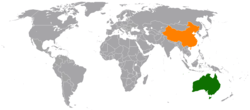 | |
Australia |
China |
|---|---|
| Diplomatic mission | |
| Australian Embassy, Beijing | Chinese Embassy, Canberra |
| Envoy | |
| Ambassador Graham Fletcher | Ambassador Cheng Jingye |
Relations between the two countries began to deteriorate in 2018 due to growing concerns of Chinese political influence in various sectors of Australian society including the Government, universities and media as well as China's stance on the South China Sea dispute.[1][2] The COVID-19 pandemic has created issues and tensions between the countries, especially Australia's calls for an inquiry into the outbreak of the disease. China's ambassador in Australia, Cheng Jingye, hinted China might boycott Australian goods as a result.[3][4]
History
Qing dynasty China
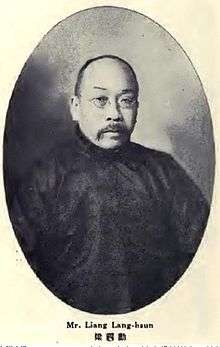
Chinese people from mainly Guangdong province in southern China have migrated to Australia since the late 1700s (the earliest reports of traders in Australia date to the 1750s at the latest) and boomed in the Victorian gold rush era.[5] By 1861, there were around 40,000 Chinese people (3.3% of the total population) living in Australia.[6] Australia during the 18th to the early 20th century were colonies - and later dominion - of the United Kingdom and focused her attention predominantly towards Europe.
Despite the long history of Chinese immigration to Australia, the first official presence of the Qing empire in Australia was not established until 1909, when Australia was a British Dominion. While the Chinese community had agitated for a Qing consulate in Australia for many years, there was reluctance from the British Foreign Office to approve such a move. After the Federation of Australia, the Chinese community's need for an official voice in Australia increased due to the push for the White Australia Policy and anti-Chinese sentiment following the enactment of the Immigration Restriction Act 1901 in Australia.[6] At the same time, Chinese republican revolutionaries were operating in Australia, and the Qing government saw a need to dissuade the Chinese diaspora against supporting the republicans. Reflecting the political debate in China, Chinese Australians had by 1900 formed branches of the Chinese Empire Reform Association to press for reform in China.[7]
The Qing Consulate-General in Melbourne became the main conduit for relations between Australia and China from 1909. Mei Quong Tart, had for years been favoured as the first Chinese Consul-General by the Chinese community, the European consular corps, as well as the Australian Prime Minister, but he died in 1903 before the Consulate-General had been set up. Instead, the first Consul-General was Liang Lan-hsun, an imperial official and experienced diplomat. However, the consul's attention was focused on trade relations, not discrimination against Chinese migrants.[7]
Republic of China
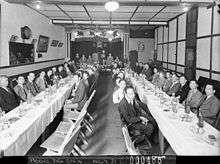
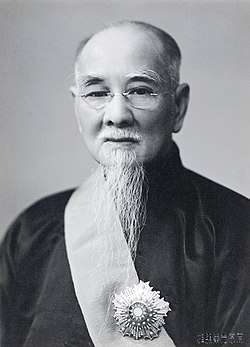
On 1 January 1912, the Republic of China replaced the Qing empire. The Consulate-General immediately set about mobilising the Chinese community in support of the new government, collecting funds and sending delegates to elect overseas Chinese deputies in the new Chinese parliament. Different political factions in China found support in Australia: while the Consulate-General sponsored groups supporting Yuan Shikai's Beijing government, the opposing Chinese Nationalist League (later a branch of the Kuomintang) was formed in Sydney in 1916. A relaxation in Australia's racial exclusion laws led to broader people-to-people interactions. By 1924, 200 Chinese students were arriving in Australia to study in that year alone. An Australian trade commissioner was briefly stationed in China in 1921–22.
In the mid-1920s, conflict between China and Britain surrounding the Canton–Hong Kong strike created tensions between China and Australia (as a dominion of Britain) as well. Following the Northern Expedition in China, greater political unity within China bolstered the Chinese Consulate-General's confidence in criticising Australian laws that discriminated against the Chinese; they were supported domestically by a resolution at the ruling Kuomintang's Third National Conference in 1929. Australian rules against Chinese residents and visitors were relaxed in response, including making it easier for Chinese nationals to visit or study in Australia.[7]
The 1930s saw an upsurge in bilateral relations. The Consulate-General was reorganised and moved to Sydney, with sub-consulates opened in other key cities. Various Chinese officials visited Australia. In 1931–2, Lin Sen, Chairman of the National Government of China and figurehead head of state, visited Sydney and Melbourne.[7] This was the first visit to Australia by a Chinese head of state, and Lin used the opportunity to press for greater relaxation of Australia's restrictions on Chinese migration. As a mark of respect, he was given a seat on the floor of the House of Representatives. In 1934, John Latham, the deputy leader of the government, led a Mission to the Far East which visited China.[6]
In 1941, after Australia established greater independence in foreign affairs, Australia established diplomatic relations with the Republic of China. Frederic Eggleston, who previously headed the Commonwealth Grants Commission, was appointed the first minister to China in Chongqing, China's war-time capital, while Hsu Mo, deputy foreign minister, was appointed the first minister to Australia.[6] In 1948, the two countries upgraded their mutual representations to ambassadors.
People's Republic of China
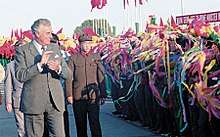
After the establishment of the People's Republic of China ("PRC") in 1949 and the retreat of the Republic of China ("ROC") government to Taiwan, Australia did not recognise the PRC. The United Kingdom proposed in 1949 that Britain, Australia and New Zealand should simultaneously recognise the new government. However, the Australian and New Zealand governments were concerned about electoral repercussions at a time when Communism was becoming a more topical issue, and did not do so immediately. Although Ben Chifley's Labor government preferred to be realistic about the new Chinese government and would have supported its admission to the United Nations,[8] it lost the election. The British government went ahead with the recognition of the PRC alone in 1950, but the United States withheld recognition. The Korean War further solidified the United States' position of supporting the Republic of China regime in Taiwan instead of the PRC. Wavering between its two traditional allies, Australia chose to follow the lead of the United States, rather than Britain, Sweden, Denmark, Finland, Norway, France, Canada, and Italy (all of which switched recognition to the PRC before 1970).
However, from 1950, Australia refused to accept ambassadors from the ROC (the mission was allowed to remain but, until 1959, was headed by a chargé d'affaires).[9] Likewise, until 1966 Australia did not send an ambassador to Taiwan. From as early as 1954, the Australian government's Department of External Affairs was recommending the recognition of the PRC, but this advice was not politically accepted. During the Cold War, Australia's strategic alignment swung further towards the United States. While the Labor Party's official policy from 1955 was that Australia should follow the examples of Britain and France in recognising the PRC, on the basis that the ROC was unlikely to recover the mainland,[10] the Liberal Party-led Coalition played up the perceived threat of a Communist China for electoral advantage, including the support of the anti-Communist Democratic Labor Party. As part of this political strategy, Australian Prime Minister Harold Holt explicitly recognised the continuing legitimacy of the ROC government in Taiwan in 1966, by sending an ambassador to Taipei for the first time.[8]
The government of William McMahon sought to improve non-official relations with China, in areas such as trade and culture, but China was not receptive to such exchanges without diplomatic recognition.
As opposition leader, Gough Whitlam visited China in 1971 (before Henry Kissinger's historic visit on behalf of the United States), and in December 1972, after Whitlam's victory in that year's federal election, Australia established diplomatic relations with the People's Republic of China, and Australia ceased to recognise the Republic of China government of Chiang Kai-shek in Taiwan.[11][12] Although Whitlam's decision was informed by warming relations between China and the West generally, especially the United States, Australian diplomatic relations with the People's Republic predated that of the United States by seven years. The establishment of relations with "Red China" roused great excitement in Australia.[13] Stephen Fitzgerald became the first Australian ambassador to the People's Republic of China, and Wang Guoquan was the first PRC ambassador to Australia.
Since the Chinese economic reforms initiated by the late Deng Xiaoping, China has benefited from significant investment in China by Australian companies (for example, future Prime Minister Malcolm Turnbull had set up the first Sino-foreign joint venture mining company in China in 1994), while Australia has benefited from the Chinese appetite for natural resources to modernise its economy, infrastructure and meet its growing energy demands.[14] In 2009, it was estimated the trade and investment with China brought benefits of close to $4000 per Australian household; in 2011, this was estimated to be A$10,500 per household per year.[14]
China and Australia were the final two bidders for the 2000 Olympics. Australia subsequently won and Sydney hosted the 2000 Olympics. Eight years later, China hosted the Beijing Olympics in 2008.
Australia is one of the few countries in the world during the global financial crisis that was not in recession. Its continued economic growth due to that period is partly attributed to large demand and long term strong fundamentals from China.
As China's influence raises, the Chinese government has been trying to control and monitor the ethnic Chinese living and studying in Australia, and to influence Australian politicians via political donors, which causes serious concern to Australia's security agency, Australian Security Intelligence Organisation.[15] The Chinese foreign ministry responded that such a charge was groundless. The national security department of China accused the Australia intelligence agency of trying to collect information from overseas Chinese, and even encouraging them to subvert Chinese government.[16]
Hong Kong
Australia's ties to China include its relations with Hong Kong which date back to when both were under British rule. Although Hong Kong, as a special administrative area of China, cannot conduct its own foreign affairs, consular and economic representations exist. Australia maintains a consulate in Hong Kong, while Hong Kong maintains the Hong Kong Economic and Trade Office in Australia.
Taiwan
While Australia no longer recognises the Republic of China as the legitimate government of China (or Taiwan), unofficial relations are maintained between Australia and Taiwan. The Taiwan government operates the Taipei Economic and Cultural Office in Australia, which fulfills most of the functions of an embassy and consulates at an unofficial level. The Australian counterpart in Taiwan is the Australian Office in Taipei.
Cultural relations
Australia has been a haven for Chinese migrants for centuries who have, in the modern day, established themselves as a significant minority group in Australian society. There are now large numbers of Australian-born Chinese and Chinese-born migrants/Australian Citizens in the cities of Melbourne, Sydney, and Brisbane with small Chinese communities in regional centres, particularly in Victoria, and New South Wales. There are also Chinatowns in every Australian capital city, including Darwin and large, public Chinese New Year Celebrations in Melbourne and Sydney. The former Prime Minister, Kevin Rudd, also has strong connections with Chinese culture having studied Chinese at the Australian National University in Canberra. His daughter is married to a Chinese man, and Mr. Rudd also speaks fluent Mandarin.
Former Prime Minister Malcolm Turnbull's son is married to a Chinese woman.[17][18]
China has established many Confucius Institutes with Australia universities in major capital cities in Australia to foster better cultural ties.[19]
Education relations
Australians have gone to China to study since the 19th century. William Mayers studied in China from 1859, and was involved in negotiations to bring the first railway and steam engine to China.[6] In 2011, China was overall the most popular destination for Australian students studying overseas. It was the most popular destination for Australian students undertaking short-term studies overseas, the seventh most popular destination for long-term studies, and also the seventh most popular destination for practical placements.[20] In 2014, there were 4,700 Australians studying in Chinese universities, and in 2015 the Australian government's New Colombo Plan was expected to send 525 tertiary students to study in China.[21]
There is also a long tradition of Chinese students going to Australia to study. The numbers were small initially: a total of only 30 students entered Australia to study between 1912 and 1920. In 1924, about 300 Chinese students entered Australia to study. They were mostly children of residents.[7]
Australia began accepting Chinese students for tertiary education in 1986 in English Language Intensive Courses for Overseas Students (ELICOS). Several thousands Chinese were studying in Australia in 1987.[22] In the aftermath of Tiananmen Square protests of 1989, the Australian government granted protection for about 20,000 Chinese students in Australia.[13][22] Since then, Australia has become one of the biggest markets for Chinese students for tertiary education.[23] In early 2011, there were over 126,000 Chinese students in Australia[23] and they made up 26 percent of the total foreign students.[23][24] As of September 2011, there were 150,000 Chinese students studying at Australia tertiary institutions.[25] The Australian education export market was worth 2009/10 A$19 billion.[26] The well-developed nature of Australia-China education relations has spawned a thriving sphere of bilateral youth engagement, with non-government organizations such as the Australia China Youth Association, Australia-China Youth Dialogue, Australia-China Young Professionals Initiative, and Engaging China Project receiving high-level government and university support to connect thousands of young Australians and Chinese to academic, cultural, and professional exchanges.[27][28][29][30][31]
Economic relations
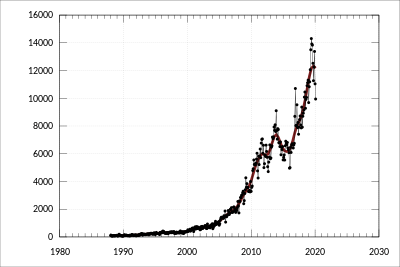
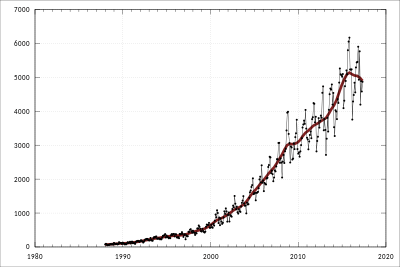
Before 1912
Although Chinese traders were reportedly present in Australia from the 1750s, bilateral trade was small scale until the 20th century. Australia's trade relations were heavily geared towards the British Empire, and at Federation in 1901, trade with China accounted for 0.3% of Australian merchandise trade flow. At that time, Australia mainly imported tea and rice from China, as well as certain luxuries such as silk. Chinese imports from Australia were focused on minerals (silver, gold, copper and pig lead), but also included grains.[6]
1912 to 1972
During the early 20th century, agricultural produce began to make up a larger share of Australian exports to China, including a growing demand for Australian butter and wheat. By 1917–18, Australia was exporting 950,825 pounds of butter to China. Meanwhile, Australian demand for silk and other textiles increased during the early 20th century.
World War II disrupted trade between Australia and China. In the post-war decades, wool became an important Australian commodity imported by China. From the 1960s, however, agricultural shortages in China led to heavy imports of Australian wheat. By the early 1970s, China still accounted for only 1% of Australia's merchandise trade flow.[6]
Since 1972
A few years after the establishment of diplomatic relations between Australia and the People's Republic of China, China began market-orientated reforms, which led to a significant and increasing expansion of bilateral trade. China is Australia's biggest trading partner mainly due to China's strong demand for iron ore, coal and liquefied natural gas.[32] Exports to China helped Australia escape the worst effects of the global financial crisis.[33]
Many major Australian mining companies rely heavily on China and other growing big economies such as India for exports. These companies include Fortescue Metals Group, Rio Tinto, BHP Billiton and Xstrata who have major Australian operations.
China exports mainly clothing, telecommunications equipment and components, computers, toys, prams and sporting equipment.[32]
The bilateral trade between the two countries is worth A$105 billion in 2010/2011.[32] Australia's exports to China totalled A$64.8 billion, while China's export to Australia was worth A$41.1 billion in 2010–2011 period.[32]
| Year | two-way trade |
|---|---|
| 2008 | $73.8 billion |
| 2009 | $85.1 billion |
| 2010 | $105.3 billion |
| 2011 | $121.1 billion[34] |
There are direct flights from a number of cities in China such as Beijing, Shanghai, Hong Kong SAR and Guangzhou to Brisbane,[35] Melbourne, Adelaide and Sydney. Recently, China Southern Airlines have commenced scheduled commercial flights to Perth from Guangzhou in early November 2011.[36] China Southern has its pilot training facilities in Australia for many years. They are in Jandakot and Merredin which were established in 1993.[36]
There were initial fears of Chinese investment in the resource sector similar to the sentiments on Japanese investments in Australia in the 1980s,[37] but that has somewhat heated up and dissipated depending on the investments which were scrutinized by the Foreign Investment Review Board and politicians.[38][39][40][41] Australia is focused on investments which have a win win situations with participation of local companies participation and jobs growth.[39]
Australia has been a vital source of the high technology needed for China to enforce its claims to vast reaches of the western Pacific, including the base technology for the design of the Houbei class missile boat.[42]
On 8 April 2013, Australian Prime Minister Julia Gillard announced the deal that the Australian dollar is set to become only the third currency after the US dollar and the Japanese Yen to trade directly with the Chinese yuan during a trip to Shanghai.[43]
To encourage Australian entrepreneurship in Greater China, the Australian Chamber of Commerce of Greater China organises every year the Australia-China Business Awards (ACBA) which recognise companies that have worked to deliver Australian products or services to the Greater China region.[44]
The China–Australia Free Trade Agreement was signed on 17 June 2015.[45]
Australia has raised security concerns over Chinese involvement in 5G wireless networks with a risk that cellular network equipment sourced from Chinese vendors may contain backdoors enabling surveillance by the Chinese government (as part of its intelligence activity internationally) and Chinese laws, such as the China Internet Security Law, which compel companies and individuals to assist the state intelligence agency on the collection of information whenever requested.[46]
In February 2018, over fears of rising Chinese influence, the Australian Government announced tougher rules on foreign buyers of agricultural land and electricity infrastructure.[47]
In March 2020 during the Coronavirus crisis, Australia brought in new rules to prevent foreign takeovers of Australian companies, after MPs in the Australian Parliament expressed concerns that companies impacted by the Coronavirus pandemic economic slowdown would become vulnerable to buyouts by state-owned enterprises in regimes like China.[48]
In April 2020, Australian Border Force intercepted faulty PPE (Personal protective equipment) kits that had been imported from China to help halt the spread of coronavirus.[49][50]
Relations deteriorated further in May 2020 after Australia called for an independent investigation into the initial coronavirus outbreak in China.[51] In an apparent retaliation, on 12 May 2020, China banned import of beef from four Australian beef processing firms, constituting about 35% of Australia's beef exports to China.[52]
From 19 May 2020, China instituted an 80% tariff on barley imports from Australia. China stated the tariffs were the culmination of multi-year Chinese investigations into Australian dumping and Australian government subsidies; the Australian trade minister rejected the Chinese claims as "completely ridiculous". The previous week, China had unfrozen barley imports from the United States. Annual estimates (dated around 2017–2018) state China grows less than two million tonnes of barley per year and imports about nine million tonnes of barley per year. Australia grows about nine million tonnes per year, three times as much as the entire US.[53]
On 25 May 2020, the Chinese Govt warned Australia against siding with the US in a trade war, saying "if Australia showed any support for the US, it would deliver the Australian economy a fatal blow" and "if Canberra supports Washington... it means Australia may feel more pain than the US."[54]
The Australian Govt announced on 19th June 2020 that there had been a spate of cyber-attacks on Australian businesses and government agencies from a "sophisticated state based actor", without naming China directly. However, Australian Government sources said there was a high degree of confidence that China was behind the cyber-attacks.[55]
In June 2020, the Chinese Government also issued a travel warning to Chinese-Australian diaspora and Chinese international students from studying in Australia, claiming an increase in racial discrimination and violence against Chinese people.[56][57]
Political relations
Whilst economic relations between China and Australia have increased significantly to the benefit of both nations, Australia under the previous Howard Government has appeared reluctant to pursue closer political/military ties with China and has maintained the role that George W. Bush controversially dubbed "America's Deputy" in the Asia-Pacific Region.[58]
China is emerging as a political and economic power in the Asia Pacific region which is traditionally anchored by the United States. Australia is a Middle power country like many Asian countries which have security arrangements with the United States but growing economic ties with China.[59] 77% of Australians see China as an economic partner with only 15% seeing it as a military threat. 39% see China posing a threat militarily to Australia in the next 20 years, down from 48% in 2014.[60]
Howard Government
When, on 15 June 2007, the Prime Minister John Howard received the Dalai Lama,[61] China protested, with official critics.[62]
Rudd Government
The election of Kevin Rudd as Prime Minister of Australia was seen as favourable to Sino-Australian relations, notably in view of the fact that he was the first Australian Prime Minister who speaks fluent Mandarin, and that closer engagement with Asia was one of the "Three Pillars" of his foreign policy.
In 2004, Rudd, who at the time was Shadow Minister for Foreign Affairs, delivered a speech in Beijing entitled "Australia and China: A Strong and Stable Partnership for the 21st Century".[63]
In February 2008, Australia reportedly "chastised Taiwan for its renewed push for independence" and "reiterated its support for a one-China policy".[64] In April, however, Rudd addressed Chinese students at Peking University,[65] and, speaking in Mandarin, referred to "significant human rights problems in Tibet".[66][67] Rudd also raised the issue in talks with Chinese Premier Wen Jiabao, in a context of "simmering diplomatic tension" according to TV3.[68]
Prime Minister Rudd received lukewarm response from China about his Zhengyou terminology used to describe Australia's relationship with China.[69][70]
In July 2009, following the arrest in China of Australian mining executive Stern Hu, accused of spying, Rudd intervened to "remind our Chinese friends that China [...] has significant economic interests at stake in its relationship with Australia and with its other commercial partners around the world".[71] Later in August 2009, the PRC government protested against the Australian government after Rebiya Kadeer was granted a visa to visit Australia to attend the Melbourne International Film Festival.[72] Along with the Rio Tinto espionage case and the failed bid for Chinalco to purchase a higher stake in the Rio Tinto Group, such events are generally considered as lowest ever points in Sino-Australian relations for the past few years.[73] China has also effectively banned visits by senior Australian officials, in protest against the events in question.[74]
Despite the souring of relations within 2009, on 19 August 2009, Chinese petroleum company PetroChina signed an A$50 billion deal with ExxonMobil to purchase liquefied natural gas from the Gorgon field in Western Australia,[75][76] considered the largest contract ever signed between China and Australia, which ensures China a steady supply of LPG fuel for the next 20 years, and also forms as China's largest supply of relatively "clean energy".[77][78][79]
Gillard/Rudd Government
The Gillard/Rudd government has maintained strong economic ties with China through agreements to explore clean energy and to make sure Australia remains a longstanding and reliable supplier of energy and natural resources.[80] Australia under Prime Minister Julia Gillard/Kevin Rudd has stated will continue positive and constructive engagement with China but maintaining security ties with the United States based on shared values.[81]
Following his nomination as Australian prime minister, Kevin Rudd visited China's foreign minister, Yang Jiechi, before visiting Japan, and subsequently organized a meeting between Yang and the Australian foreign minister, Stephen Smith, in which Australia unilaterally announced its departure from the Quadrilateral Security Dialogue amidst Chinese displeasure at Australia's participation.[82] Within Australia, this decision was seen as motivated by the uncertainty of China-United States relations and by the fact that Australia's principle economic partner, China, was not its principle strategic partner.[83] Rudd may furthermore have feared regional escalations in conflict and attempted to diffuse these via an "Asia-Pacific Union."[82]
Rudd's replacement as Australian prime minister by Julia Gillard in June 2010 was associated with a shift in Australian foreign policy towards a closer relationship to the United States alongside a revival of interest in participation in the Quadrilateral and a distancing from China.[84] The Australian, which has written extensively on the Quadrilateral and on Australian defense issues, argued after Rudd's replacement that "Australia's national interest is best served by continuing to engage and encourage our long-standing ally, the US, to retain its primacy in the region."[84] Despite Gillard's rapprochement with the US and increased US-Australian military cooperation, Rudd's decision to leave the Quadrilateral remained an object of criticism from Tony Abbott and the Liberal Party.[85]
Gillard government's action to station US troops in Australia has been strongly criticised and viewed with suspicion by China as it asserted that the defense pact could undermine regional security.[86] An article in the Sydney Morning Herald reported that Gillard declared that, "China has nothing to fear from an American military build-up near Darwin and knows that Australia and the US are long-time allies."[87]
In April 2013, Gillard went to China and met with new Chinese President, General Secretary Xi Jinping and new Chinese Premier Li Keqiang with Foreign minister Bob Carr and Trade minister Craig Emerson to secure closer ties with China and economic relations.[88]
Abbott Government
Defence Minister Senator David Johnston has expressed his belief that Australia does not need to "choose between the US and China." Speaking on behalf of the coalition government, he further stated "we see that there is a balance between our relationship with China and sustaining our strong alliance with the United States."[89]
On 17 November 2014, Australia and China finalised a deal which saw a Free Trade Agreement established between the two nations.[90]
Chinese leader Xi Jinping addressed a joint-sitting of the Upper and Lower Houses of Australian Parliament in November 2014, lauding Australia's 'innovation and global influence'.[91]
Turnbull Government
Australia has been among the firmest opponents of China's territorial claims to the South China Sea. In July 2016, following the ruling by an international tribunal which held that China holds "no historical rights" to the South China Sea based on the "nine-dash line" map,[92][93] Australia issued a joint statement with Japan and the United States calling for China to abide by the ruling, as "final and legally binding on both parties."[94] In response, Chinese state-run media called Australia a paper cat.[95] Later in the year, in response to an Australian swimmer's critical comments towards Chinese swimmer Sun Yang over a past doping experience, state media labeled Australia "Britain's offshore prison... on the fringes of civilization."[96] Later that year, Japanese, Indian, Australian and American officials met to continue security cooperation ahead of the ASEAN and East Asia Summits in November 2017.[97] The meeting included discussion of China's increased prominence in the South China Sea, and may have signaled U.S. president Trump's interest in reviving a formal Quadrilateral with Australian, Indian, and Japanese cooperation.[98]
In June 2017 after a Four Corners investigation into supposed Chinese attempts to influence Australian politicians and exert pressure on international students studying in Australia, Turnbull ordered a major inquiry into espionage and foreign interference laws. It also claimed that despite Australian Security Intelligence Organisation warning both parties about Chinese interference in democratic processes, significant financial contributions continued to be accepted.[99] A spokeswoman for the Chinese Foreign Ministry derided the investigation as "totally pointless" and suggested that Australian media was "creating obstacles" for further co-operation.[100] Former Defence Secretary Dennis Richardson also claimed that China was conducting espionage in Australia and that intelligence agencies may be currently involved in stopping foreign interference.[101] In December 2017, opposition MP Sam Dastyari resigned after a political scandal where he was accused of contradicting the Australian Labor Party's policy on the South China Sea, as well facing accusations of accepting financial favours from Chinese companies.[102] Then Malcolm Turnbull expressed his criticize with "Australian people stand up" in both Chinese and English.[103] Shortly afterwards, the Coalition Government announced plans to ban foreign donations to Australian political parties and activist groups.[104] This was a remarkable turn of events as Australia historically had no restrictions on political donations from outside of the country.[105]
In 2018, in the Lowy Institute poll there had a sharp rise in the proportion of the Australian population who say the Australian government is "allowing too much investment from China".
This number risen from 56 per cent in 2014 to 72 per cent in 2018.[106]
Morrison Government
In July 2019, the United Nations ambassadors from 22 nations, including Australia, signed a letter condemning China's mistreatment of the Uyghurs as well as its mistreatment of other minority groups, urging the Chinese government to close the Xinjiang re-education camps.[107][108]
According to the New York Times, many countries including Australia saw worsening relations with China during the COVID-19 pandemic.[109] In April 2020 the Australian Government's call for an investigation into the causes of the pandemic provoked angry responses from Chinese state media and government officials. Some Chinese statements, such as Chinese ambassador Cheng Jingye's statements that tourism and trade to Australia would suffer due to Australia's "attitude", have been interpreted as attempted "economic coercion". Hu Xijin, editor-in-chief of the Global Times, stated "Australia is always there, making trouble. It is a bit like chewing gum stuck on the sole of China's shoes. Sometimes you have to find a stone to rub it off." Australia also criticized China for breaking protocol by "releasing purported details of official diplomatic exchanges".[110]
In June 2020, Australia openly opposed the Hong Kong national security law.[111] On July 9, 2020, Australian Prime Minister Scott Morison said that following the fear of China’s new national security law, it has suspended the extradition treaty with Hong Kong.[112]
Diplomatic offices
The Chinese embassy is located in Canberra, ACT in Australia.[113] There are consulates in major cities such as Sydney, Melbourne, Brisbane, Perth.
The Australian embassy is located in Beijing.[114] Australia also has consulates in major cities such as Shanghai, Guangzhou and Hong Kong.[114]
See also
| Wikimedia Commons has media related to Relations of Australia and China. |
- Australia China Relations Institute, in German
- Belt and Road Initiative#Australia, Japan, India and the US 'Indo-Pacific Vision'
- China–Australia Migratory Bird Agreement
- Criticism of Confucius Institutes#Australia
- Daigou#Australia
- Foreign relations of China
- List of ambassadors of Australia to China
- List of ambassadors of China to Australia
- Sino-Pacific relations
- Anti-Chinese sentiment in Australia
References
- "Why China is becoming a friendlier neighbour in Asia". South China Morning Post. 27 May 2018.
- Hamilton, Clive (2018). Silent Invasion: China's influence in Australia. Melbourne: Hardie Grant Books. p. 376. ISBN 978-1743794807.
- Coronavirus: China’s new army of tough-talking diplomats
- China relations sour over tariff threat to Australian barley
- Wu, C. (13 April 2006). Let us work to bolster Sino-Australian ties. China Daily, pp. 4–4.
- Au-Yeung, W., et al(2012), "Australia-China: Not just 40 years Archived 2013-01-30 at the Wayback Machine", Economic Roundup, 2012(4)
- Jones, P., "The View from the Edge: Chinese Australians and China, 1890 to 1949", in Ferrall, C. et al (ed.) (2005), East by South: China in the Australasian Imagination, pp.46ff
- The Whitlam Institute, "Australia-China Relations before Recognition", in Whitlam and China, 2012
- The unexpected embassy: establishing, maintaining and ending Australian diplomatic representation in Taipei
- The Whitlam Institute, "Whitlam's Advocacy for Diplomatic Recognition", in Whitlam and China, 2012
- "Sino – Australia Relations" Archived 20 July 2011 at the Wayback Machine, Embassy of the People's Republic of China in Australia
- Downer, Alexander (17 October 2002). "Australia and Recognition of the People's Republic of China: 1949–1972". Australian Ministry of Foreign Affairs. Retrieved 4 July 2012.
- Ferrall, C., "An Introduction to Australasian Orientalism", in Ferrall, C. et al (ed.) (2005), East by South: China in the Australasian Imagination, pp.9ff
- Sino-australian relations. (2011). Engineering and Mining Journal, (00958948), 59–62,64.
- "The party line". The Sydney Morning Herald. Retrieved 5 June 2017.
- Australia’s spy work on China increases, says security staffer.
- Editor, John Garnaut, Asia-Pacific (15 September 2015). "Is Malcolm Turnbull 'soft' on China because of his family connections?". The Sydney Morning Herald.CS1 maint: extra text: authors list (link)
- hermes (23 September 2015). "Turnbull has Chinese daughter-in-law". The Straits Times.
- "Archived copy". Archived from the original on 23 December 2011. Retrieved 2011-11-16.CS1 maint: archived copy as title (link)
- SPRE - Australian Outbound Student Mobility - Snapshot Archived 24 October 2015 at the Wayback Machine
- Zhao, Xinying, "More Australians wish to study in China", China Daily, 30 March 2015
- Gao, J. (2006). Organized international asylum-seeker networks: Formation and utilization by Chinese Students1. The International Migration Review, 40(2), 294–317.
- Philipp Ivanov (26 July 2011). "Australia and China's higher education revolution".
- "Archived copy". Archived from the original on 20 November 2011. Retrieved 2011-11-16.CS1 maint: archived copy as title (link)
- International Education Group Department of Education, Employment and Workplace Relations (September 2011). "Monthly Summary of International Student Enrollment Data1 – Australia – YTD September 2011" (PDF). Australian Government.
- DFAT (2011). "Analysis of Australia's Education exports" (PDF). DFAT. Archived from the original (PDF) on 27 February 2012.
- "Society, Culture and Arts". Retrieved 20 October 2016.
- "Archived copy". Archived from the original on 9 November 2014. Retrieved 2014-11-09.CS1 maint: archived copy as title (link)
- "404 Error! - Asia Education Foundation" (PDF). Retrieved 20 October 2016.
- "Growing youth movements fusing China-Australia ties - Xinhua - English.news.cn". Retrieved 20 October 2016.
- "Mandarin in the Lingua Franca of Youth Dialogue". The Australian. Retrieved 22 October 2016.
- "Archived copy" (PDF). Archived from the original (PDF) on 28 November 2011. Retrieved 2011-11-17.CS1 maint: archived copy as title (link)
- "Australia Signs Mammoth Gas Deal With China". VOA.
- "Home". Retrieved 20 October 2016.
- China southern airlines launches flights to Brisbane, Australia. (18 October 2010). Asia Pulse, pp. n/a.
- First direct flight from china to western australia lands. (9 November 2011). Asia Pulse, pp. n/a.
- Natasha Bita (2 July 2011). "Land rush". The Australian.
- Rick Wallace (8 April 2010). "Japanese investment in Australia slips under the radar". The Australian.
- Damon Kitney (26 October 2011). "Foreign investment must be win-win: Gary Gray". The Australian.
- John Brumby (16 August 2011). "Chinese investment an opportunity, not a threat". The Australian.
- Andrew Burrell (30 September 2011). "Barnett's 'mixed signals' on Chinese investment". The Australian.
- Lague, David. "Insight: From a ferry, a Chinese fast-attack boat." Reuters, 31 May 2012.
- "China and Australia in currency pact". BBC News. 10 April 2013. Retrieved 20 October 2016 – via www.bbc.co.uk.
- "About - AustCham China - ACBAs". 9 August 2013. Archived from the original on 9 August 2013.
- "China-Australia Free Trade Agreement (ChAFTA)". Austrade. austrade.gov.au/. Retrieved 13 October 2015.
- "Hobbling Huawei: Inside the U.S. war on China's tech giant". Reuters. 21 May 2019. Retrieved 21 May 2019.
- "Australia toughens foreign investment rules amid China concerns". Strait Times. 1 February 2018.
- Smyth, Jamie (30 March 2020). "Australia tightens investment rules on foreign takeovers". Financial Times.
- Greene, Andrew (1 April 2020). "Australia seizes faulty coronavirus protective equipment imported from China". ABC News.
- ""DODGY" PPE MASKS FROM CHINA WORTH $1.2 MILLION SEIZED AT BORDER: REPORT". Australian Manufacturing Forum.
- Dziedzic, Stephen (20 May 2020). "Australia started a fight with China over an investigation into COVID-19 — did it go too hard?". ABC News.
- Chandler, Ainslie (12 May 2020). "China Blocks Some Australian Beef Imports Amid Rising Tension Over Calls for Coronavirus Investigation". Time.
- Hurst, Daniel (19 May 2020). "Why has China slapped tariffs on Australian barley and what can Australia do about it?". The Guardian. Retrieved 13 June 2020.
- Fernanda, Gavin (25 May 2020). "Faulty batch of face masks prompts the isolation of more than a thousand Spanish healthcare staff". NZ Herald.
- Packham, Colin (19 June 2020). "Australia sees China as main suspect in state-based cyberattacks, sources say". Reuters.
- Fang, Jason (7 June 2020). "Chinese Australians caught in the crossfire from Beijing's Australian travel warning". ABC News.
- "Coronavirus: China warns students over 'risks' of studying in Australia". BBC. 10 June 2020.
- Sydney, By Nick Squires in (16 October 2003). "Anger as US pins sheriff badge on Australia". Retrieved 20 October 2016.
- ABC (14 November 2011). "Northern defence". ABC Newsline.
- Graham, Euan (16 June 2015). "Lowy poll: On China and energy, Australia maintains its sunny disposition". the interpreter. Lowy Institute. Retrieved 16 June 2015.
- "John Howard meets Dalai Lama to talk Tibet". Retrieved 20 October 2016.
- "Conférence de presse du 12 juin 2007". Retrieved 20 October 2016.
- "Australia and China: A Strong and Stable Partnership for the 21st Century" Archived 26 January 2005 at the Wayback Machine, Kevin Rudd, 6 July 2004
- "China, Australia hold strategic meeting" Archived 10 April 2008 at the Wayback Machine, The Age, 5 February 2008
- "China rejects Rudd advice" Archived 14 April 2008 at the Wayback Machine, News.com.au, 10 April 2008
- "Australian PM Kevin Rudd warns China over human rights abuses in Tibet", Jane Macartney, The Times, 9 April 2008
- "Aussie Rules", The Independent, 10 April 2008
- "Kevin Rudd raises concerns over Tibet", TV3, 10 April 2008
- Rowan Callick, Asia-Pacific editor (7 December 2010). "Rudd may come unstuck over China relations". The Australian.
- "Rudd rewrites the rules of engagement". smh.com.au. 12 April 2008.
- "Australia warns China on spy case", BBC, 15 July 2009
- Rowan Callick, 31 July 2009, Uighur Rebiya Kadeer gets visa despite China protest Archived 2 August 2009 at the Wayback Machine – The Australian
- Greg Sheridan, Michael Sainsbury, 18 August 2009, Beijing bites back over Kadeer visa and iron ore prices Archived 12 October 2009 at the Wayback Machine – The Australian
- Stephen McDonell, 19 August 2009, Record gas deal between China and Australia – AM – Australian Broadcasting Corporation
- Babs McHugh, 19 August 2009, Massive sale from Gorgon Gas Project – Australian Broadcasting Corporation
- David McLennan, 20 August 2009, Australia to be 'global supplier of clean energy' Archived 18 September 2009 at the Wayback Machine – The Canberra Times
- 20 August 2009, CNPC to import 2.25m tons of LNG annually from Australia – ChinaDaily (Source: Xinhua)
- Peter Ryan, 19 August 2009, Deal means 2.2 million tonnes exported per year – AM – Australian Broadcasting Corporation
- Matthew Franklin in Beijing (27 April 2011). "Julia Gillard rejects need to contain China". The Australian.
- Matthew Franklin; Michael Sainsbury (26 April 2011). "Julia Gillard's US-China balancing act". The Australian.
- Gordon, Josh, "Diabolical dilemmas in PM’s China high-wire act". Sunday Age, 5 April 2009.
- Lee, John, "PM May Trump Rudd in Managing China". The Australian, 17 August 2011.
- Frydenberg, Josh, "Washington is integral to our region". The Australian, 21 September 2010.
- Sheridan, Greg, "Popular reflections finding no favour in Beijing". The Australian, 18 November 2011.
- Ben Packham (17 November 2011). "China reproaches Australia over strengthened US defence ties". The Australian.
- Flitton, Daniel (20 November 2011). "Gillard tells China not to fear US marines". SMH.
- John Garnaut and Mark Kenny (7 April 2013). "Gillard urges closer Asian ties to ease tensions". The Sydney Morning Herald.
- Roggeveen, Sam (23 September 2013). "What the new defence white paper will say about China". www.lowyinterpreter.org. Lowy Institute for International Policy. Retrieved 23 September 2013.
- Robb, Andrew (17 November 2014). "Landmark China-Australia Free Trade Agreement". trademinister.gov.au. Commonwealth of Australia. Archived from the original on 6 April 2016. Retrieved 18 November 2014.
- "The Chinese President has begun addressing the Australian parliament". Special Broadcasting Service. 17 November 2014. Retrieved 18 November 2014.
- "PCA Press Release: The South China Sea Arbitration (The Republic of the Philippines v. The People's Republic of China) | PCA-CPA". pca-cpa.org. Retrieved 12 July 2016.
- Perlez, Jane (12 July 2016). "Tribunal Rejects Beijing's Claims in South China Sea". The New York Times. ISSN 0362-4331. Retrieved 12 July 2016.
- Wen, Philip (26 July 2016). "South China Sea: Australia in three-way rebuke of China". The Sydney Morning Herald. Retrieved 2 September 2016.
- "China warns Australia must 'cautiously behave' over South China Sea". 1 August 2016. Retrieved 20 October 2016.
- "China labels Australia 'offshore prison' in Olympic drugs row". 8 August 2016. Retrieved 20 October 2016.
- "Quadrilateral security dialogue: India, Australia, Japan, US hold talks on Indo-Pacific cooperation". Times of India. 12 November 2017. Retrieved 16 November 2017.
- Wyeth, Grant (16 November 2017). "Why Has Australia Shifted Back to the Quad?". The Diplomat. Retrieved 16 November 2017.
- Gribbin, Caitlyn; Uhlmann, Chris (5 June 2017). "Malcolm Turnbull orders inquiry following revelations ASIO warned parties about Chinese donations". ABC News. ABC. Retrieved 6 June 2017.
- Needham, Kirsty (5 June 2017). "Chinese government hits back at student spying claims in Australia". The Sydney Morning Herald. Fairfax Media. Retrieved 6 June 2017.
- Tingle, Laura (12 May 2017). "Dennis Richardson accuses China of spying in Australia". Financial Review. Fairfax Media. Retrieved 6 June 2017.
- Remeikis, Amy (12 December 2017). "Sam Dastyari quits as Labor senator over China connections". The Guardian. Retrieved 12 December 2017.
- "'Australian people stand up!' Malcolm Turnbull invokes Mao in war of words with China". Shanghaiist.com. 11 December 2017. Retrieved 30 December 2018.
- Murphy, Katharine (5 December 2017). "Coalition to ban foreign donations to political parties and activist groups". The Guardian. Retrieved 21 February 2018.
- Westbrook, Tom (4 December 2017). "Australia, citing concerns over China, cracks down on foreign political influence". Reuters. Retrieved 21 February 2018.
- "Australians are losing trust in the US, a new poll shows". SBS News.
- "Which Countries Are For or Against China's Xinjiang Policies?". The Diplomat. 15 July 2019.
- "More than 20 ambassadors condemn China's treatment of Uighurs in Xinjiang | Xinjiang | The Guardian". amp.theguardian.com.
- Erlanger, Steven (3 May 2020). "Global Backlash Builds Against China Over Coronavirus". The New York Times. Retrieved 4 May 2020.
- https://www.theguardian.com/world/2020/apr/29/chewing-gum-stuck-on-the-sole-of-our-shoes-the-china-australia-war-of-words-timeline
- Lawler, Dave (2 July 2020). "The 53 countries supporting China's crackdown on Hong Kong". Axios. Retrieved 3 July 2020.
- "National security law: Australia suspends Hong Kong extradition treaty". BBC. Retrieved 9 July 2020.
- "Foreign embassies and consulates in Australia - Australian Government Department of Foreign Affairs and Trade". Protocol.dfat.gov.au. 22 June 2016. Archived from the original on 30 November 2011. Retrieved 22 October 2016.
- Trade, corporateName= Department of Foreign Affairs and. "Australian Embassy in". Retrieved 20 October 2016.
Further reading
| Library resources about Australia–China relations |
- Abbondanza, Gabriele, The Geopolitics of Australia in the New Millennium: the Asia-Pacific Context (Aracne, 2013)
- Fung, Edmund S.K. and Colin MacKerras, From Fear to Friendship: Australia's Policies Towards the People's Republic of China, 1966–1982 (University of Queensland Press, 1985)
- Mitcham, Chad J., China's Economic Relations with the West and Japan, 1949-79: Grain, Trade and Diplomacy, Routledge, 2005.
- Shee Ping, Wong, The Poison of Polygamy, trans. Ely Finch (Sydney University Press: 2019)
External links
- The international education industry – APH data on Chinese students numbers from 2002 to 2006.
- James Laurenceson. "Chinese Investment in Australia" (PDF). East Asia Economic Research Group Discussion Paper No. 12, July 2007. School of Economics, The University of Queensland, Queensland: East Asia Economic Research Group.
- Peter Drysdale; Christopher Findlay. "Chinese foreign direct investment in the Australian resource sector" (PDF). China's New Place in a World in Crisis, 2009. Canberra, Australia: ANU. Archived from the original (PDF) on 13 April 2011.
- China embassy, China-Australian relations
- Australian embassy in Beijing
- Grand Stakes: Australia's Future between China and India by Rory Medical, Strategic Asia 2011–12: Asia Responds to Its Rising Powers – China and India (September 2011)
- "Man at work: Rudd walks Asian tightrope", Tanja Vestergaard, Asia Times, 17 April 2008: a five-page analysis of Sino-Australian relations in early 2008
- Australia countering China’s growing influence in South Pacific
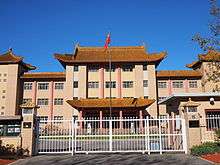
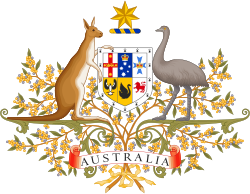
.svg.png)